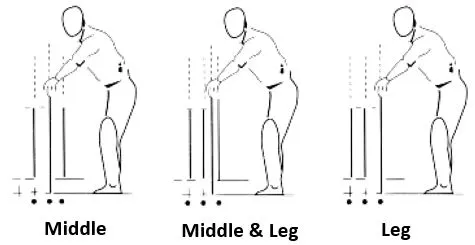What is a batting guard?
A cricket batting guard is a crucial element in a batter’s game. It allows you to keep track of where your stumps are from ball to ball, and means you can be confident both leaving and playing the ball.
Taking guard usually involves holding your bat up straight and side on so the edge is facing down the pitch, and asking the umpire to help you line up your bat with one of the stumps. The batter then often marks the pitch with their studs or bat so they have a more permanent mark on the crease to refer to.
Three of the most common batting guards
Common Batting Guards
We will cover the more common batting guards: Leg, Middle, Off and Middle and Leg (often referred to as “two”. These refer to which stump or stumps you are lined up with.
Middle Stump Guard:
As the name suggests, the batter takes a guard in the middle of the wicket. This is a very common guard and provides a nice balance between the opportunity to score runs on the offside and the leg side. If you are a beginner then we would recommend you start with a middle stump guard. You can then alter it if necessary as you gain further experience and understand your strengths and weaknesses.
Leg Stump Guard:
The batter takes a guard on the leg side of the wicket in line with the leg stump. This seems to be becoming less common. Its major advantage is opening up the offside of the pitch, so this guard can be very useful if your strengths are driving through the covers, cutting the ball and generally playing through the offside. However, be careful as the more leg side you stand, the more your stumps may be exposed and you risk increasing the chance of getting bowled by straight balls.
Off Stump Guard:
The batter takes a guard on the off side of the wicket in line with the off stump. This can be very effective if you are confident playing straight balls off your legs. Essentially you increase the change of the ball being on a middle or leg stump line, so can capitalise. This guard tends to be for more aggressive players, but be warned - you may increase the risk of lbw as you will be covering most of the stumps with your pads. If you get too far over to the offside you also risk getting bowled “around your legs”, particularly if the ball is spinning or seaming.
Middle and Leg Stump Guard:
Many players find the leg stump guard too extreme, and a middle and leg stump or “two”, can be a nice balance for those wanting to open up the off side without exposing too much of their stumps.
Choosing the best Batting Guard
There are a number of options as to the guard you want to take and how that subsequently positions you at the crease. You should consider the following when taking guard, as well as understand that you can retake and change guard throughout your innings depending on many factors:
The type of bowler.
Consider the type of bowler - are they bowling pace or spin? Are they bowling on a consistent line and length? How are they trying to get you out? It is helpful to get in the mind of the bowler and consider what their plans will be and how you can negate this. For example, a bowler who is consistently bowling outside off stump rather than directly at the stump may be looking for you to edge the ball. Can you alter your guard and stance so you are further to the offside, knowing that you will be able to leave any ball outside your eye line and that there is less chance of an LBW?
The condition of the pitch.
The condition of the pitch can also influence your choice of batting guard. Is the pitch spinning large amount, and which way? If you are right handed facing an off-spinner and the ball is spinning into you, could you take a more offside guard to negate the spin and get closer to where the ball is pitching?
Your strengths and weaknesses.
Consider your strengths and weaknesses as a batter. If you are strong off your legs and when the ball is straighter, could you take a more offside guard to maximise the opportunity for scoring runs? If you prefer to hit through and over the offside, could you take a more legside guard, to free up your arms and so more balls are landing in your zone?
Your trigger movement.
Do you move your feet automatically as the bowler releases the ball? This can fundamentally change where you are standing and may change the guard you would want to take in the first place. Go to a net and get someone to video you batting and then examine your trigger movements. We are often not aware of how we move when batting.
Understand your own game
In conclusion, choosing the right batting guard can have a significant impact on your game. It is essential to consider all the factors. In general, the more you know and understand your own game, the better. Analyse how you bat and work out your strengths and weaknesses. How can you maximise your strengths and negate your weaknesses by your choice of guard? Get in the nets and experiment with different guards and see what works best for you.
Best of luck!

